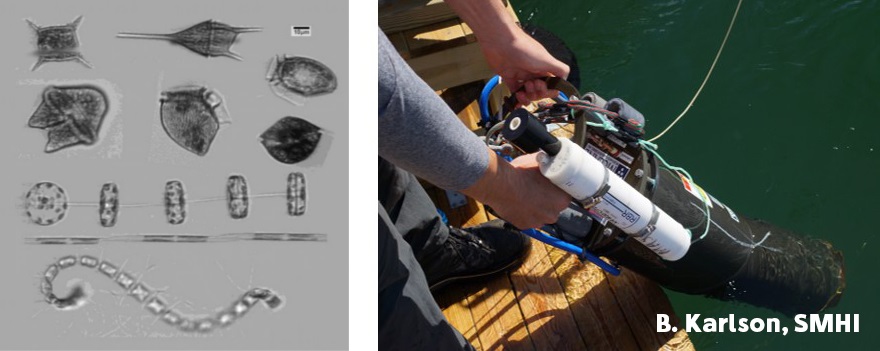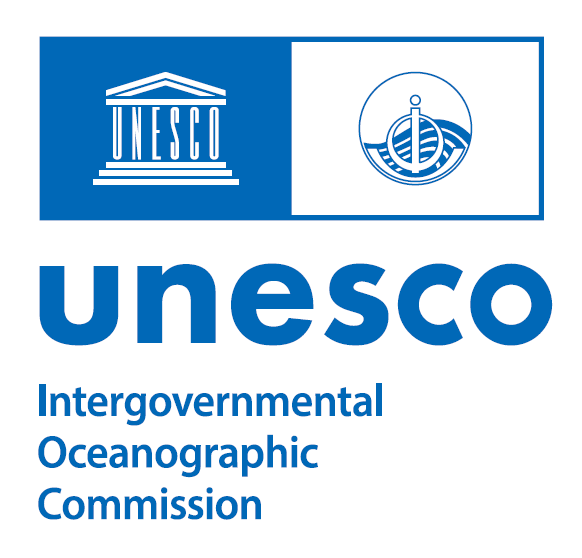Overall objective: To improve the detection and prediction of HABs by developing capabilities in observation and modelling.

Left: Images of phytoplankton from an imaging flow cytometer (Imaging FlowCytobot) deployed in situ near a mussel farm on the Swedish west coast in 2016. Right: The Imaging Flow Cytobot. The white instrument is a CTD. Photos: Michael Brosnahan (WHOI, US) and Bengt Karlson (Swedish Meteorological and Hydrological Institute, Sweden). Dinophysis acuminata, Lingulodinium polyedrum and a ciliate are seen in the mosaic of images. Right: The Imaging Flow Cytobot. The white instrument is a CTD. Photos: Michael Brosnahan and Bengt Karlson.
Rationale. GEOHAB highlighted the need for specialized and highly resolved measurements to observe and describe the biological, chemical, and physical interactions that determine the population dynamics of individual species in natural communities. Furthermore, it emphasized the central role of long-term coordinated observation and effective monitoring systems to develop and evaluate early warning and prediction systems, and to support decision-making for the protection and management of coastal resources. During the lifetime of GEOHAB, technical advances improved our ability to observe HABs (see e.g., HABWATCH 2004, GEOHAB 2013, Berdalet et al. 2014).
Closely related to observation is modelling, also identified as an essential tool for HAB prediction and management. Specific tasks were conducted under GEOHAB, a major one being the Modelling Workshop held in Galway, Ireland (GEOHAB 2011). Improvements needed in modelling HABs include better parameterization of the biological, physical and chemical processes of interest, as well as model validation. These improvements require high-resolution sampling of the appropriate parameters, resolving small scales (e.g., thin layers in stratified systems, rheological processes at the micrometer-length scale), and sustaining long time series of observing systems that measure environmental forcing in relation to HAB and plankton community response.
There are several different types of HAB models. The ones that have the most predictive power for short-term HAB forecasts are often site- and organism-specific. These models do not always give general biological insight and are the hardest to scale up to be used for producing scenarios for novel combinations of environmental conditions (e.g., under future climate or other anthropogenic change). However, modeling efforts focused on short-term predictive power can be complemented with analysis of positive ecological feedbacks (e.g., Sunda and Shertzer 2014) or trait-based approaches that model phytoplankton community strategies instead of species. These approaches have the potential to generalize across many HAB species or populations. In any effort at generalization and upscaling, international coordination is fundamental for advancement.
Specific objectives
- Develop capabilities to observe HAB organisms in situ, their properties (e.g., life stages, nutritional condition), and the processes that influence them.
- Develop capabilities in real-time observation (with capacity to resolve fine-scale processes, such as thin layers) and prediction of HABs.
- Develop and evaluate systems for long-term monitoring of HAB species.
- Establish and endorse the continuation of long-term HAB sentinel sites and encourage their inclusion in climate change observing systems where the data are made freely available in international databases. This objective is especially linked to the GlobalHAB Theme 12. Climate Change and aligns with international programmes and initiatives such as GOOS (Global Ocean Observing System) and the ICES Working Group on Harmful Algal Bloom Dynamics (WGHABD).
- Promote the use of new technologies (e.g., in situ imaging flow cytometry, molecular methods, mooring and profiling instruments and automated underwater vehicles, AUVs) with established methodologies in monitoring programmes. This objective reinforces the themes on “Aquaculture” and “Climate Change” (Themes 7 and 12 respectively).
- Encourage multi-method approaches to study HAB dynamics where in situ observations are combined with remote sensing and modeling. To accomplish this, it is important to foster multi-and cross-disciplinary collaborations centered on specific HAB prediction problems.
- Develop models to describe and quantify the biological, chemical, and physical processes related to HABs.
- Develop capabilities for describing and predicting HABs with empirical models.
- Encourage long-term investment in biological modeling approaches with the potential to generalize across many HAB species or populations (e.g., trait-based approaches), as a complement to modeling efforts focused on short-term predictive power.
- Improve model formulations linking land-use models with regional ocean models, and that incorporate dynamic physiological behavior.
- Develop modelling capabilities for projecting the response of HAB species to climate change (see Theme 12. Climate Change).
Example tasks
- Organize special sessions on observation tools at relevant scientific conferences, such as ICHA, ASLO, phycological meetings, Ocean Optics, Trait-based Approaches to Ocean Life workshop series, etc.
- Contribute towards activities planned by ICES-IOC WGHABD in the 2018-2020 period, such as reviewing progress in development and routine application of molecular genetic technologies for taxonomic identification, phylogenetic reconstruction, biodiversity, toxin detection and population dynamic studies of HABs.
- Organize a workshop on imaging methods (imaging flow cytometry, in situ video, etc.), bio-optical methods and remote sensing, including satellites and airborne (aircraft and drones) to detect HABs.
- Encourage and facilitate international collaboration to compile and share data on HAB species and events in OBIS (www.iobis.org) and its Harmful Algae Event Database component HAEDAT (haedat.iode.org).
- Cooperate and interact with GOOS sections including the “Biology and Ecosystem Panel”, and regional level regional ocean observing systems (ROOSes), such as EuroGOOS (www.eurogoos. org) in Europe that includes BOOS (Baltic Operational Oceanographic System, www.boos.org), NOOS (North West European Shelf Operational Oceanographic System, noos.eurogoos.eu), IBI-ROOS (Ireland-Biscay-Iberia Regional Operational Oceanographic System, www.ibi-roos.eu), MONGOOS (Mediterranean Operational Network for the Global Ocean Observing System, www. mongoos.eu), Black Sea GOOS, and Arctic ROOS.
- Interact with the EU Marine Strategy Framework Directive (MSFD), where HABs are included in the Eutrophication section.
Outcomes
- Improved capabilities in early warning and real-time observation and prediction of HABs.
- Complete long time series on HABs and related environmental parameters that will allow determining trends on HAB species and events (HAEDAT, GHSR) in different regions.
- Review advances in novel technologies for HAB research and monitoring applications including, for example, toxic gene detection in the field.
- INFORMATION FOR POLICY MAKERS: scientifically sound information on HAB trends, especially in the context of climate change, to develop policies aimed at the protection and management of coastal resources and human health.
References
The complete list of references can be found here.


